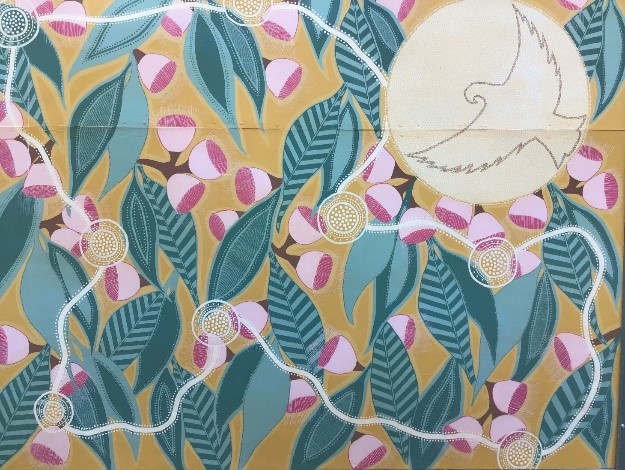Singleton Heights Preschool Inc. resides on the traditional lands of the Wannaruah/Wonnarua people. My involvement at Singleton Heights Preschool began in 2014 as an Inclusion support Educator. Before this role I had a background in Aboriginal Health and Community Development and worked in various Aboriginal community organisations. As an Aboriginal woman and Educator, I place great value on inclusive practices and guiding our children’s connection to their culture and country. My work has been greatly influenced by the children, families, community, and our Director of the Preschool, who is also passionate about creating a culturally safe place for our children and families, as well as an anti-bias approach that requires ongoing collaborative work.
My role as the “Aboriginal Community Liaison and Program Mentor” Role has evolved and grown over time. While still engaging in my inclusion support role, I looked at ways of embedding culture, and sharing ideas and practices with my team. In the early days I created a “Reconciliation Policy” to be included in our centre policies, to better reflect our commitment, beliefs, practices and local community context and connections. As a team, we also renewed our commitment to building on our Aboriginal cultural knowledge and to continually improve the cultural safety of our Pre-School community.
We contacted community organisations to facilitate local, culturally appropriate workshops for the staff in our service. Our cultural competence training consisted of both internal and external training, through which our learning and un-learning began. Un-learning much of what was taught to us at school and learning about truth, disadvantage and discrimination, and the impacts of inter-generational trauma. In response to our service context, we have also engaged in mental health, domestic violence and culturally informed trauma training. This learning journey is continuous, and we constantly reflect as a team to ensure we are meeting the needs of our children, families, and local community.
Curriculum inclusions that have been embedded along the way within our program include; our daily Acknowledgement to Country, nature walks, language, cooking experiences, Indigenous literature, art, children’s stories, music, instruments, dolls and clothes, furnishings and pictorial displays of children’s learning and projects. We have built a wonderful collection of authentic Aboriginal artefacts including coolamons, possum skins and recycled plastic mats for use in the outdoor environment. These aren’t brought out for special events but are a constant inclusion in our environment.
Our outdoor environment is also rich in opportunities to immerse the children in Aboriginal culture. Several large murals certainly stand out but our large natural playground and surrounding bush area, abundant bird life, and resident lizards, all promote learning about respecting and caring for the environment, our connection to country and promote sustainable practices which are rich in Aboriginal culture. We ensure that any addition, including a metal eagle representing “KawaL’, have a sign attached, which tells the story and facilitates learning as any adult can read and share the culturally accurate information with the children. The establishment of our Yarning Circle has had a positive impact in our outdoor space. This is a place where rooms gather as group to share time in our natural outdoor environment, surrounded by native birds and the occasional blue-tongue lizard, but also where children will independently move to, to share time together during free play.
The addition of a “Physical Acknowledgement of Country” at the entrance to the Pre-School along with our written “Acknowledgement”, have also been significant in promoting a sense of welcome, respect and cultural safety for new families and visitors to our service. We designed two metal boxes which were cut to expose images relevant to our local community and are lit at night. Our mining connection, the importance of the railway, the Hunter River which runs through our town, farming, Mount Yenga, and our Aboriginal animal artworks are all depicted as the important parts of our local community.
My role has afforded me the opportunity to extend our resources and time in all classrooms to share culture with the children. One of my favourite memories was sharing the book ‘Baby Business’ with one of the rooms. We had recently purchased coolamons and possum skins and through the story, conversation and questions from the children, the story was brought to life, with the children’s interest and learning being visible, real and exciting.
Over time, the strong relationships formed with our local Aboriginal community members, has transformed our thinking, approaches, and values. These relationships have enriched our learning environments, provided opportunities for them to be part of our program and service events, facilitated excursions to local sacred Aboriginal sites, and have impacted families and community.
I engaged the services of our local Wannaruah/Wonnarua artist, who I also call a dear friend. Aunty Denise created a mural in our playground, an experience she shared with the children. She also painted four original animal paintings especially for our service. Her art is respectfully displayed in one of the main areas in the Pre-School, and has been included on our signs, in official documents and website. “Kawal” the eagle, is the totem of the Wannaruah/Wonnarua nation and we have also incorporated Aunty Denise’s painting of Kawal, as a part of the logo on our uniforms. These links with our Elders in community are vital for creating and embedding a culturally safe place and maintaining respectful relationships.
Our connection with community and Elders has been significant in providing culturally appropriate experiences and knowledge for our children, and Pre-School community. Uncle Warren, a local Elder has been our guide on excursions on Country, when we visit “Baiame Caves”, a culturally significant place for the Wannaruah/Wonnarrua people. On this excursion, the children are emersed in the stories and culture of our people, while being on Country. The atmosphere and scale of the main cave and ancient paintings provide a powerful opportunity for learning for the children, attending family members and Educators and the bushwalking part of the excursion really allows us all to enjoy nature. This excursion is a highlight and one we look forward to doing each year.
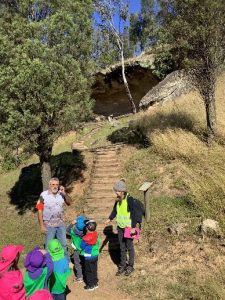
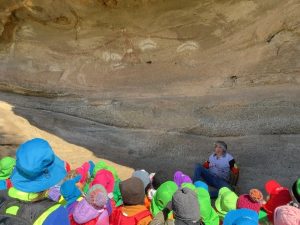
The “Puwampi Unti Kunarr” dancers, are a group of local Indigenous high school students who we also have an ongoing and strong connection with. One of our Educator’s has a son who is a part of this group and he is passionate about his culture and loves to come with the group. They paint the children’s faces using traditional ochre and as they share traditional dance, and cultural knowledge, as they explain the meaning of each dance and their movements. It is a very powerful experience when they invite the children and Educators to dance with them. 80 children, 12 high school students and 12 Educators moving together in traditional dance, to the beat of the tapping sticks, on the grass under our ironbark tree. On occasion, we’ve also been fortunate to incorporate a smoking ceremony.
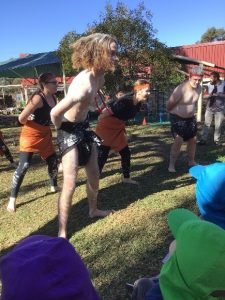
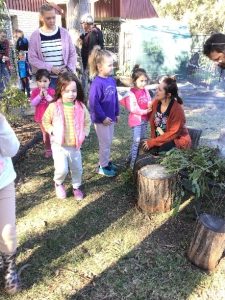
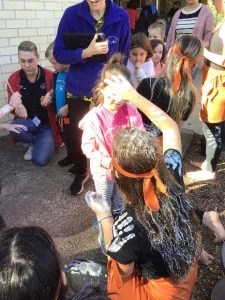
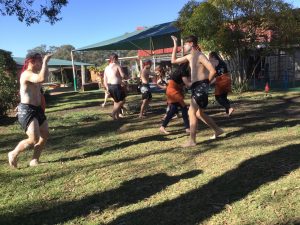
We have also engaged with a second High school group in our community, the is “Clontaff Academy”. The group of boys have visited our Pre-School sharing art activities with the children, reading traditional stories, playing games and sharing a meal. Aunty Michelle is also a regular visitor, sharing stories, art and craft activities with our children. Each of our respected visitors share knowledge and culture with our children and staff which we are so appreciative and grateful for.
Beyond these community connections I am continually searching for opportunities to expand my personal knowledge. I am currently looking at language workshops both in Wannaruah/Wonnarua, and my own Gathung language, to further my knowledge and that which I can share with others. I have also been busy making connections with Pre-Schools outside of our area, including a Director of a Preschool on the Torres Strait Islands to share our preschool experiences. A few of our children were interested in the Australian flags, in particular, the Torres Strait Island flag. We explored the Torres Strait Island culture and learned a traditional dance, “Taba Naba”.
Extending upon the learning from this experience and engaging with the program cycle, The children then engaged with me and we started painting flags to hang in our outdoor environment. This goal was also documented in our service “Reconciliation Action Plan”, (RAP), and through reflective collaboration between the children, families, Educators, Management Committee, and local Elders, we agreed the flags should be created with hooks attached so they are easily moved. After several months of painting, the children have helped to create our own respectful interpretation of the Australian, Aboriginal and Torres Strait Islander flags, which can be placed in the playground, or at the entrance to the Pre-School. This project also became a link to our service Quality Improvement Plan as do a number of goals identified in our RAP each year.
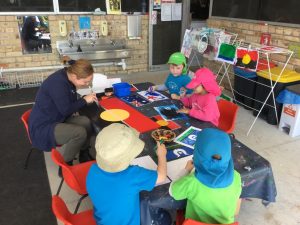
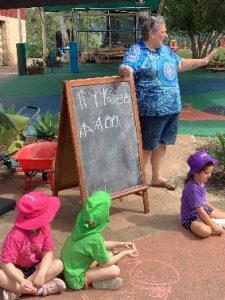
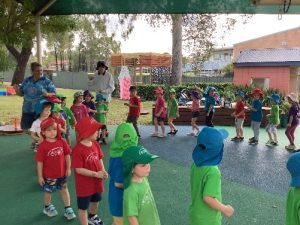
External opportunities that we incorporate into our program each year include culturally significant days such as Reconciliation Week, Sorry Day, NAIDOC week and Indigenous Literacy Day. This year for Indigenous Literacy Day the children enjoyed watching the live event which featured children from communities around Australia, along with Jessica Mauboy and Gregg Dreiss. The children were intrigued by the language, fishing and cooking, and wanted to ‘watch it again’. It was a great opportunity to incorporate language and showcase the many language groups which exist across Australia.
Within my role I have also played an integral part in the reflective practice, collaboration, development, implementation and continual review of our service “Reconciliation Action Plan”. We engage with the “Narra Gunna Wali” portal for educational services, creating and publishing an annual plan. We aim to capture our service commitment and goals within the plan, to ensuring culture is embedded in all areas of our curriculum, practices, conversations, relationships and continual improvement. For me, I see reconciliation as appreciation and understanding of the rights and wrongs of our history. The history of these stories needs to be shared, which is an important step of reconciliation. Our Pre-School acknowledges and takes an active role in learning about our shared histories, cultures, and achievements, and in building respectful relationships. To achieve this, we will maintain our relationships with Aboriginal community groups and organisations by inviting them to Preschool for special events or to participate in our program. We will continue to source opportunities for professional development and learning. We will collaborate with local schools through the AECG to support the EYLF Practice relating to continuity of learning and transitions for Aboriginal and Torres Strait Island children, through the completion of a PLP for those moving into school. Our “Acknowledgement to Country” is displayed and read at all gatherings, meetings and events.
This has been an adventure of connecting, learning, and listening. Our team has a shared vision of improving outcomes for Aboriginal children and their families. Our “Reconciliation Action Plan”, and the outcomes, are possible when we have strong relationships and a commitment to respectful partnerships.
My role has evolved over time, and I constantly reflect on how much growth has happened for me personally and professionally. My own artwork is now featured as a mural in the outdoor environment at our service. The mural came about after a visit from “Speaking in Colour”, during which the children participated in an art mapping experience of our service. We walked around our outdoor environment doing leaf rubbings and animal (possum, emu, eagle) walks. We gathered near the blank canvas on the fence where we drew an outline of our mapped area. Included in the mapping were areas where we gather such as the yarning circle, outdoor classroom, camp kitchen, cubby house, sandpit, and our classrooms.
Afterwards, one of the children suggested painting the board, with another suggesting painting Kawal, the eagle. Over the next few days, the children revisited the leaf rubbing and collected natural items they had found including gum leaves and a pink gum blossom to paint, while one adorned herself with a gumnut leaf skirt, bracelet, and head piece that she had made. Walking past the board back to our room it was suggested we paint some blossoms and gumnut leaves. Inspired by the children’s interests and ideas, I put together a painting on canvas and invited Aunty Denise to share her artistic skills and collaborate in the painting of the mural. The children were excited to begin the project with many of them and other Educators participating in the painting process.
The children’s voices are valued and considered, as depicted in the ‘mini mural’ which was then created within our room. “Can we do some painting like the mural?”, one asked and another suggested “Can we put the eagle on it?”. The children that were interested keenly cut out leaves using a template, and the mini mural began. This experience links to Quality Area 1.2.2 and 1.2.3 Educational Program and Practice. Educator’s respond to children’s ideas and play and extend children’s learning through open ended questions, interactions, and feedback. Each child’s agency is promoted, enabling them to “make choices and decisions that influence events and their world”. The children truly inspire our teachings and promote engaging experiences, extension of learning and positive relationships.
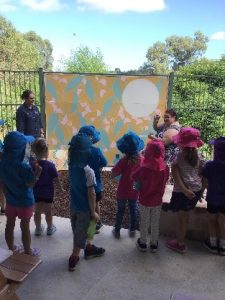
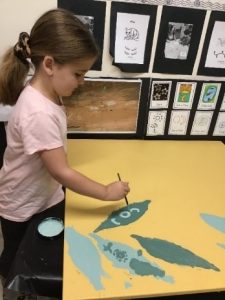
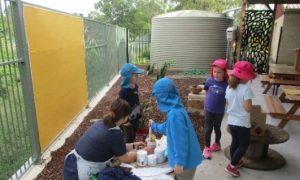
We had Aunty Denise and Uncle Warren view the mural in its early stages. Aunty Denise came to help, and we painted together, Uncle Warren was happy with the depiction of Kawal on the smaller canvas. Having the input of our local Elders is crucial in maintaining relationships and the appropriate sharing of culture.
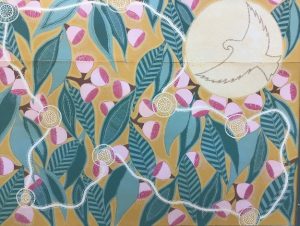
Written by Amy Green, a proud Worimi/Biripi woman
